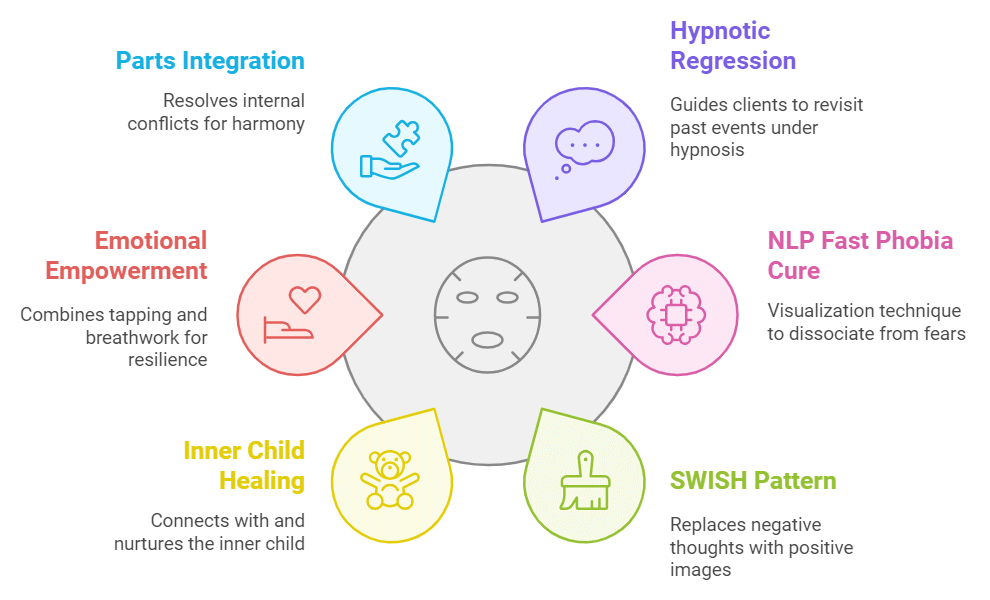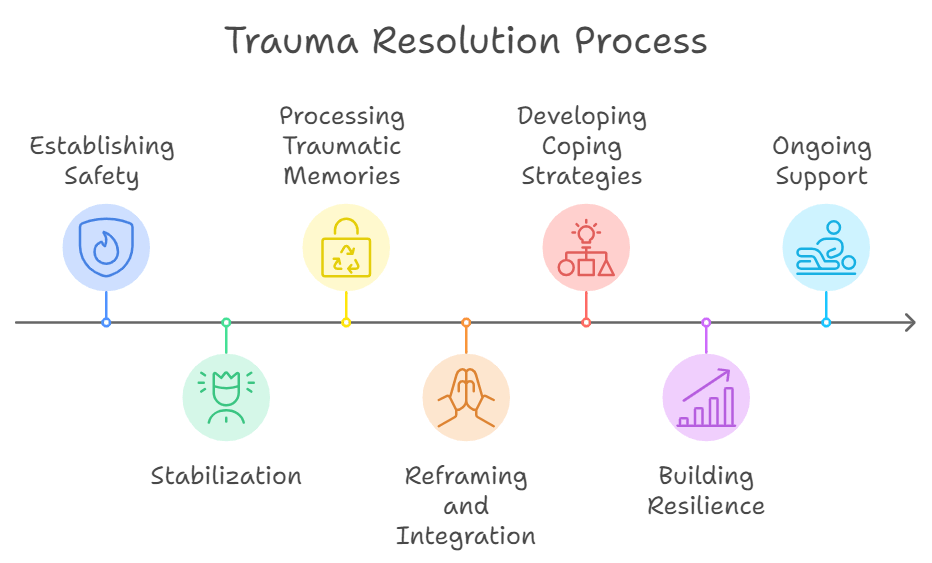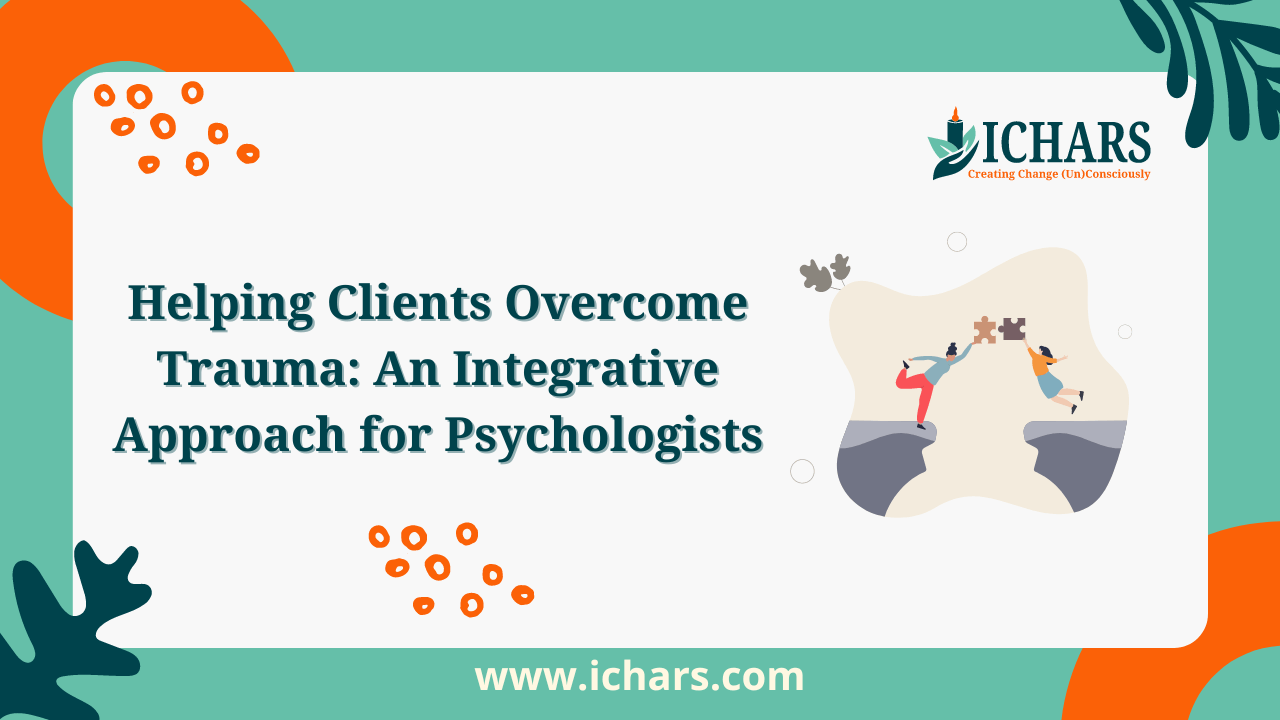Are you struggling to help clients who are haunted by traumatic memories and can’t seem to move forward?
Do you find that traditional therapeutic methods sometimes fall short in providing the relief your clients desperately need?
Cognitive Hypnotic Psychotherapy (CHP) offers a comprehensive, integrative solution that combines hypnosis with multiple psychotherapy techniques, equipping you with a robust framework to help clients heal from trauma effectively.

Understanding Trauma
Trauma can result from a single event or ongoing stressors. It often leads to symptoms such as anxiety, depression, flashbacks, and emotional numbness. The key to effective treatment is a holistic approach that acknowledges the complex interplay of the client’s thoughts, emotions, and behaviours.
The Cognitive Hypnotic Psychotherapy Approach to Overcome Trauma
CHP is an eclectic and comprehensive approach that integrates hypnosis with multiple psychotherapy techniques. This method not only addresses the symptoms of trauma but also the underlying causes, promoting long-term healing and resilience. Here are several key techniques used in CHP that can be particularly effective in treating trauma:
Key Techniques for Treating Trauma

1. Hypnotic Regression Therapy
Hypnotic Regression Therapy involves guiding clients back to past events under hypnosis to uncover and process traumatic memories. Supported by numerous studies, this technique can help clients understand the root causes of their trauma, facilitating the release of pent-up emotions and the restructuring of harmful beliefs.
Application: During sessions to help client overcome trauma, psychologists can use regression to safely explore traumatic memories, helping clients reframe their experiences and reduce the emotional impact.
Case Example: A client with recurring nightmares about a childhood event is guided through a hypnotic regression session, where they re-experience the event from a detached perspective, leading to significant reductions in nightmare frequency.
2. NLP Fast Phobia Cure
The NLP Fast Phobia Cure is a visualization technique designed to quickly dissociate clients from the fear-inducing aspects of their trauma. By creating a mental distance between the client and the traumatic event, this method reduces the intensity of the emotional response.
Application: This technique is particularly useful for clients with specific phobias or intense flashbacks. Through guided visualization, clients can re-experience the trauma in a detached manner, diminishing its power over their present life.
Case Example: A client with a severe phobia of driving after a car accident uses the Fast Phobia Cure technique, visualizing the event as a distant movie. Over several sessions, their anxiety decreases, and they gradually resume driving.
3. SWISH Pattern
The SWISH Pattern helps clients replace negative thought patterns associated with trauma with positive, empowering images. This NLP technique disrupts undesirable mental associations and reinforces new, constructive ones.
Application: Psychologists can guide clients through exercises where they visualize the negative thoughts and then “swish” them out, replacing them with positive images that evoke feelings of safety and control.
Case Example: A client who experiences intrusive thoughts about a past assault is taught the SWISH Pattern, which helps them replace these thoughts with images of personal strength and safety.
4. Inner Child Healing
Inner Child Healing involves connecting with and nurturing the client’s ‘inner child’—the part of them that retains childhood experiences and emotions. This technique helps address unresolved issues from the past that continue to affect the client’s present behaviour and emotional state.
Application: By creating a safe space for the client to engage with their inner child, psychologists can facilitate healing from deep-seated childhood trauma, fostering a sense of self-compassion and acceptance.
Case Example: A client struggling with low self-esteem rooted in childhood neglect engages in Inner Child Healing, leading to increased self-worth and improved relationships.
5. Emotional Empowerment Technique
This holistic approach combines elements like tapping (EFT), affirmations, and breathwork to release trapped emotions within the body while fostering resilience. It’s ideal for clients who struggle with managing intense emotional responses.
Application: Psychologists can teach clients to use tapping and breathwork during sessions and as self-help techniques, empowering them to manage emotional distress between sessions.
Case Example: A client with anxiety learns tapping techniques that they use during panic attacks, significantly reducing their frequency and severity.
6. Parts Integration

Parts Integration is an NLP method for resolving internal conflicts where different ‘parts’ of the self are at odds. This technique is useful when clients experience ambivalence or struggle with decision-making due to internal conflicts.
Application: Through guided dialogue between conflicting parts, clients can achieve internal harmony, reducing the psychological burden of trauma and promoting cohesive self-identity.
Case Example: A client torn between career aspirations and family obligations undergoes Parts Integration, finding a balanced perspective that honors both aspects of their identity.
7. Ho’oponopono
Ho’oponopono is a Hawaiian practice of reconciliation and forgiveness involving four key phrases: “I’m sorry,” “Please forgive me,” “Thank you,” and “I love you.” This practice helps clients release resentment, guilt, or negativity.
Application: By incorporating Ho’oponopono into therapy, psychologists can help clients let go of negative emotions tied to their trauma, promoting emotional healing and forgiveness.
Case Example: A client harboring guilt from a past relationship uses Ho’oponopono to release these feelings, leading to a significant improvement in their emotional well-being.
8. Cord Cutting
Cord Cutting is a visualization process aimed at severing unhealthy emotional attachments to people, situations, or past events. It is particularly useful for clients who need help moving on from such attachments.
Application: During therapy sessions, psychologists can guide clients through visualization exercises to “cut cords” with past traumas, enabling them to move forward with a sense of liberation and relief.
Case Example: A client struggling to move on from a toxic relationship uses Cord Cutting, which helps them feel empowered and less emotionally entangled with their past.
9. NLP Timeline Therapy
NLP Timeline Therapy involves visualizing a client’s life timeline to identify and reframe negative emotions or limiting beliefs associated with past events. This technique helps free clients from constraints imposed by their trauma.
Application: By exploring and altering the timeline, psychologists can assist clients in releasing the emotional weight of past traumas, paving the way for positive future growth.
Case Example: A client with a history of childhood bullying re-examines their timeline, transforming feelings of inadequacy into a sense of resilience and self-worth.
10. Hypnodrama
Hypnodrama combines hypnosis with role-playing to explore different aspects of a client’s psyche or simulate interactions in a safe environment. This technique is effective for understanding interpersonal dynamics and preparing for challenging conversations.
Application: Psychologists can use hypnodrama to help clients reenact and process traumatic events, allowing them to gain insights and practice new, healthier responses.
Case Example: A client preparing for a difficult conversation with a family member uses Hypnodrama to rehearse and process their emotions, leading to a more confident and positive outcome.
Overview of the Trauma Resolution Process

Resolving trauma involves several steps that help clients process and integrate their experiences into a healthier emotional and cognitive framework. Here is an overview of the trauma resolution process:

- Establishing Safety: Creating a safe and supportive environment is crucial. Clients need to feel secure before delving into traumatic memories.
- Stabilization: Techniques such as grounding exercises, breathing techniques, and emotional regulation strategies help clients stabilize their emotions and reduce distress.
- Processing Traumatic Memories: Using methods like Hypnotic Regression Therapy, NLP Fast Phobia Cure, and Inner Child Healing, clients explore and reprocess traumatic memories in a disassociated state to minimize emotional overwhelm.
- Reframing and Integration: Techniques like SWISH Pattern and NLP Timeline Therapy help clients reframe negative beliefs and integrate new, positive perspectives into their self-concept.
- Developing Coping Strategies: Clients learn and practice coping strategies to manage future stress and prevent re-traumatization.
- Building Resilience: Techniques such as Emotional Empowerment Technique and Parts Integration foster resilience, helping clients develop a stronger, more adaptive response to life’s challenges.
- Ongoing Support: Continued therapeutic support and follow-up sessions ensure that clients maintain progress and continue to build on their healing journey.
Understanding Memory States in Trauma Therapy
During therapy sessions that focus on helping clients overcome trauma, clients often recall past traumatic memories, which can be experienced in either an associated state or a disassociated state. Understanding the difference between these states and their implications is crucial for effective trauma therapy.
Associated State vs. Disassociated State
Associated State:
- Definition: When a client experiences a memory in an associated state, they relive the event from their own perspective, as if it is happening again in the present moment. They see, hear, and feel everything from their original point of view.
- Impact: This can be intensely emotional and overwhelming. The client may experience heightened anxiety, fear, and distress, similar to what they felt during the original traumatic event. This can sometimes re-traumatize the client, reinforcing negative emotional responses.
Disassociated State:
- Definition: In a disassociated state, the client observes the memory from a detached perspective, as if they are watching it from a distance or as a third-party observer. They are not reliving the experience but are instead seeing it unfold without being directly involved.
- Impact: This creates a buffer between the client and the traumatic emotions associated with the memory. It allows the client to process the event with less emotional intensity, facilitating reflection and analysis without being overwhelmed by the original feelings.
Why Disassociation is Recommended
1. Emotional Safety:
- Reduced Re-traumatization: Ensuring clients observe memories in a disassociated state helps prevent re-traumatization. By not reliving the intense emotions of the traumatic event, clients can discuss and process their experiences more safely.
- Emotional Regulation: Disassociation helps clients maintain emotional stability during therapy sessions, making it easier for them to engage in the therapeutic process without being overcome by distress.
2. Enhanced Perspective:
- Objective Analysis: Observing memories from a third-party perspective allows clients to gain insights and understand their experiences more objectively. This can lead to a deeper comprehension of the trauma and its impact on their current behaviour and emotional state.
- Cognitive Restructuring: Disassociation aids in cognitive restructuring, as clients can more easily challenge and reframe negative beliefs associated with the trauma. This process is less daunting when the emotional charge of the memory is reduced.
3. Facilitation of Therapeutic Techniques:
- Effective Use of Techniques: Many therapeutic techniques, such as the NLP Fast Phobia Cure or Timeline Therapy, rely on the client being in a disassociated state. This state enables the techniques to work more effectively by minimizing emotional interference.
- Safe Exploration: Disassociation allows for the safe exploration of traumatic events. Clients can revisit and process these events without being retraumatized, making it easier to uncover and address underlying issues.
Practical Application in Therapy
During therapy, psychologists can guide clients to achieve a disassociated state through various methods:
- Visualization Techniques: Encouraging clients to imagine watching the traumatic event on a screen or from a distance can help them disassociate from the direct experience.
- Narrative Techniques: Asking clients to describe the event in the third person or as if they are an observer can create a sense of detachment.
- Anchoring Techniques: Using physical anchors (e.g., touching an object) to ground clients in the present moment can help them maintain a disassociated perspective while discussing past events.
Conclusion
Integrating these techniques into your therapeutic practice can significantly enhance your ability to support clients in overcoming trauma. Take the first step towards mastering Cognitive Hypnotic Psychotherapy. Embrace the power of integration and the transformative potential of these diverse approaches to help your clients overcome trauma and reclaim their lives.

